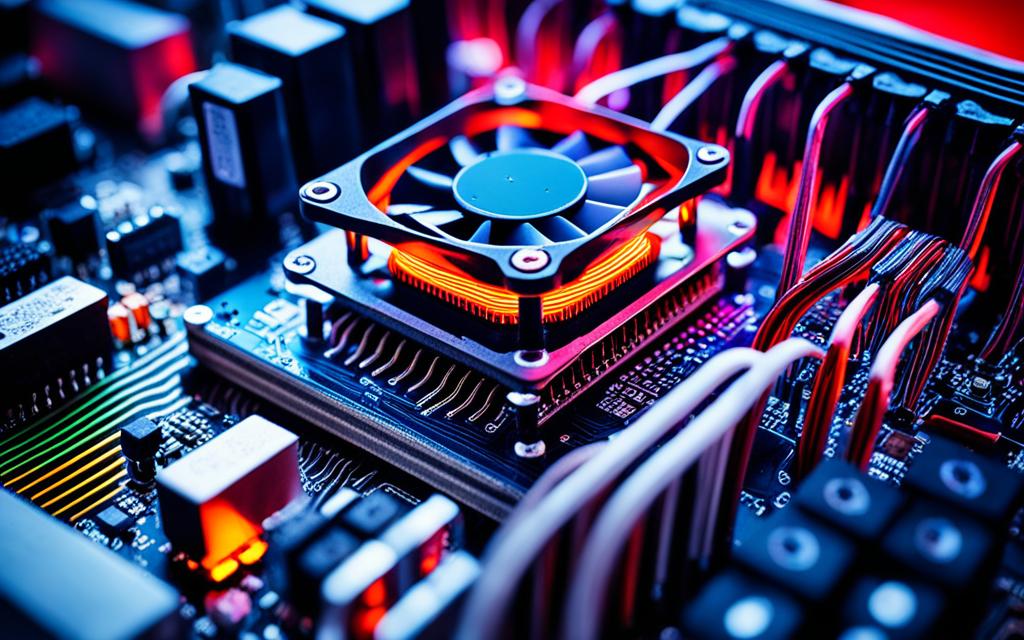Table of Contents
Controlling your PC’s fan speed is key to keeping it running well and cool. The fan speed regulates airflow, helping to keep the CPU and other components from getting too hot. Yet, it can be a bit tricky to get the flow and noise just right. This article will guide you through the essential dos and don’ts for managing your PC’s fan speed for better cooling performance.
The Importance of Fan Speed
Maintaining the right fan speed is crucial for your CPU’s optimal temperature. Though it’s tempting to keep fans at full speed for cooler temps, it leads to more noise and uses more electricity. On the flip side, too low fan speeds can mean poor cooling. This risks overheating, which may hinder performance and shorten the CPU’s life1.
Monitoring CPU Temperature
It’s important to monitor your CPU’s temperature to adjust the fan speed correctly. You can use software like HWMonitor, Core Temp, or SpeedFan for tracking. Keeping the CPU below 80 degrees Celsius is advised to avoid performance loss due to heat1.
Adjusting Fan Speed
You can adjust the fan speed in several ways. Software from PC or motherboard makers offers easy use and tends to work well. Look for tools like Alienware Command Center, Asus AI Suite, or MSI Afterburner. These often come with the computer and include options for fan control2.
Third-party software, like SpeedFan, Argus Monitor, or Fan Control, also lets you adjust CPU fan speed. While these offer more variety, they might have problems working with some systems2.
Alternatively, fan speed settings can also be changed in your motherboard’s BIOS utilities. Here, fan speed is usually shown as a percentage, from 0 to 100%, with 100% being the max2.
Choosing a Fan Curve or Profile
Setting up a custom fan curve or profile can improve cooling. Fan curves change the speed based on CPU heat, speeding up for more cooling as it gets hotter. This should be a smooth increase that balances noise with cooling effectiveness1.
Finding the right mix between temperature, sound, and power use is key. This ensures your PC cools efficiently without too much noise or using too much power1.
Testing Fan Speed
After tweaking the fan settings, check how the PC does under pressure. Use test programs like Prime95, AIDA64, or Cinebench. These tests help you see if the cooling is enough to keep temps safe. It lets you make sure the fan speed is set just right1.
Conclusion
Proper fan speed management is essential for your PC’s top performance and longevity. With the tips shared here, you can find a happy medium for cooling, noise, and power use. Keep an eye on temperatures, pick suitable fan control software, customize fan curves as needed, and test out your setup. With the right fan speed, you’ll have a PC that runs cool and smooth.
Key Takeaways:
- Monitoring and adjusting PC fan speed is crucial for maintaining optimal CPU temperature and performance21.
- Running PC fans at full speed can cause excessive noise and increased power consumption, while setting fan speed too low can lead to inadequate cooling and overheating1.
- Use software tools like HWMonitor, Core Temp, or SpeedFan to monitor CPU temperature1.
- First-party software from PC or motherboard manufacturers and third-party options like SpeedFan, Argus Monitor, or Fan Control can be used to control fan speed2.
- Customizing fan curves helps optimize cooling performance, balancing cooling efficiency and noise levels1.
The Importance of Fan Speed
Fan speed is key to keeping your PC’s CPU at the right temperature. It helps balance temperature control, noise, and power use. Understanding fan speed’s impact is essential.
Fan speed affects how much air moves through the cooling system. Higher speeds mean more airflow, which cools the CPU faster3. This keeps temperatures down.
But, high fan speeds can make more noise. This might be annoying in quiet places or during focused gaming. Also, fans running full blast use more power, but it won’t cost much more4.
Modern CPUs change fan speeds based on how hot they get. High speeds help during heavy tasks like gaming. This avoids overheating and protects the CPU4.
Yet, max speed all the time isn’t needed. Lower speeds work for light tasks, saving power and reducing noise. Optimal speed depends on your CPU, cooling system, and other factors4.
To manage fan speed, use control software or BIOS settings. Automatic controls on motherboards adjust speeds based on the CPU’s temperature4.
Keeping an eye on GPU temperature is also crucial. A temperature around 70°C is safe for heavy gaming. Using fans at 80% speed is usually fine for cooling5.
GPU fans can handle high speeds and usually last a while. Running them at 100% hasn’t shown to harm them, but watch the temperature to avoid problems5.
Choosing the right fan speed means looking at workload, ambient temperature, and noise preference. Finding this balance ensures good cooling, longer component life, and stable systems45.
Monitoring CPU Temperature
Monitoring the CPU temperature is vital for great performance and avoiding hardware damage. It helps you know if your fan speed is working right. This ensures your computer runs at a safe temperature.
Tools like HWMonitor, Core Temp, and SpeedFan give real-time temperature checks. They show important info like fan speed and voltage6.
Modern motherboards have fan controls that adjust the speed based on the CPU temperature. This keeps cooling efficient for any task7.
Using these software tools, you can find the best fan speed for your activities7. For simple tasks, a lower fan speed works well7. For heavy duties like gaming or video editing, you might need more fan power to stop overheating7.
Finding the right balance between fan noise and temperature is key. Everyone has their own preference for noise7. Regular adjustments will help keep your fan speed just right for your needs7.
10-Strike Network Monitor Pro makes monitoring easy. It tracks many parts of your computer, like CPUs and hard drives6. You can view reports and graphs to understand your system better6.
With 10-Strike Network Monitor Pro, setting up CPU temperature checks across a network is straightforward6. It’s perfect for keeping servers and workstations in top condition, all day, every day6. It’s also great for big companies with offices everywhere, bringing all the data together6.
Software Tools for Monitoring CPU Temperature
| Software Tool | Features |
|---|---|
| HWMonitor | Real-time temperature readings for CPUs, fan speed monitoring |
| Core Temp | Accurate temperature measurements for CPU cores |
| SpeedFan | CPU temperature, fan speed, and voltage monitoring |
Keeping an eye on your CPU temperature is key for a well-running system. It helps ensure your computer lasts longer and runs smoothly.
Adjusting Fan Speed
Adjusting your computer’s fan speed comes with two choices: manual or automatic. Both have their own upsides.
Manual Adjustment
To adjust the fan speed manually, you directly set its speed or voltage. You can do this through the BIOS or with your motherboard’s software. This method lets you take total control, tailoring the fan speed to your needs.
By choosing manual adjustments, you can alter the fan’s cooling power. For heavy-duty tasks or when your computer gets hot, increase the speed. When you prefer quiet, slow it down. This method lets you find the perfect balance.
But, manual adjustments mean you must keep an eye on it and tweak as needed. It might take a while to get it just right. Also, it’s not as hands-off as automatic adjustments, especially if you want the fan to adjust to changes in temperature automatically.
Automatic Adjustment
Automatic adjustment uses motherboard or software settings to change fan speed. It uses fan curves or profiles, which are plans of how fan speed will change with the CPU’s heat. This method changes fan speed in real time, offering efficient cooling without continuous manual changes.
With automatic adjustments, you can set fan curves to fit your needs. You could have the fan slowly speed up as the CPU gets hotter to keep things cool. Or, you can make sure the fan only gets louder when it really needs to. This way, your computer stays quiet.
This approach balances performance with ease. It automatically adjusts fan speed based on the CPU’s temperature, freeing you from constant checks. This means fewer distractions and more focus on what you’re doing.
If you choose automatic adjustments, you might adjust the settings in the BIOS or through software. Check both to see which offers more ease and better features for you.
Choosing the Right Method
Choosing how to adjust your fan speed depends on what you need. Manual gives you control and customization but needs more effort. Automatic offers ease and adapts to temperature, but might not be as tweakable.
For the best cooling, mix manual and automatic adjustments. Using the strengths of both gives you customised fan speed and the ease of auto adjustments.
Comparison of Manual and Automatic Adjustment Methods
| Method | Advantages | Disadvantages |
|---|---|---|
| Manual Adjustment |
|
|
| Automatic Adjustment |
|
|
When deciding between manual and automatic, think about what’s best for you. Test out different setups to find the right balance for your system.
Regardless of your choice, finding the ideal fan speed is key for cooling and a smoothly running computer.
Choosing a Fan Curve or Profile
Fan control is key to stop your PC from getting too hot. It’s important to pick the right fan curve or profile for controlling fan speeds.
A fan curve or profile sets how the fan speed changes with the CPU temperature. It lets you adjust your system’s fans for optimal cooling.
You can create custom fan curves through the BIOS or use software like Fan Control for more flexibility. This lets you change fan speeds based on how hot your system is, keeping it cool.
Creating a fan curve or profile means finding a balance between keeping things cool and keeping noise down. A good curve increases fan speed as the CPU gets hotter and reduces it when it cools down.
Changing fan speed gradually helps avoid sudden loud noises. It also reduces fan wear, which makes them last longer.
[10] Fan Control software lets you customize your experience with different layouts, colours, and start-up settings.
Running fans at full speed all the time makes more noise and can shorten their life. So, balancing is key.
Choosing the right temperature sources, like the CPU or GPU, helps make cooling more effective. It’s important for matching cooling with where heat is coming from.[10]
Different tasks need different fan speeds. For things like web browsing or office work, a slower fan speed works fine.[7]
But for gaming or video editing, which make your CPU work harder, you might need faster fan speeds to avoid overheating.[7]
Many modern motherboards adjust fan speeds based on CPU temperature automatically. This makes it easier to keep your system cool without manual adjustments.[7]
Checking the CPU temperature and fan speeds regularly helps you set the most efficient speed. This keeps your PC running well for what you need.[7]
Saving your settings in Fan Control software is important. It keeps your fan adjustments and customizations, making fan management easier and more consistent.[10]
Testing Fan Speed
Testing and adjusting your PC’s fan speed is key for optimal performance. It prevents your computer from overheating. Using tools like Prime95, AIDA64, and Cinebench helps. They simulate intense workloads to heat the CPU, letting you check if your fan settings are right.
While running a stress test, keep an eye on the CPU temperature and fan speed. You should also listen to how loud the fans are and note the power usage. These details tell you if your cooling system works well. This way, you’ll know if adjustments are needed to keep a good balance between performance and temperature.
It’s vital to check the CPU temperature when it’s running normally and under pressure. The tools we mentioned can show you the temperature in real time. This helps you see how well your fans cool the CPU. Loud fans or fans that always run fast might mean your cooling isn’t sufficient.
You can tweak fan speeds in the BIOS and GPU software. Adjusting fan curves lets you control how temperature relates to fan speed. This method helps find a middle ground between keeping things cool and keeping noise down. It ensures that your PC remains quiet while effectively cooling the parts that need it.
A quiet PC that cools efficiently needs the right setup. Choose quality parts, like specific GPUs, to keep noise low. Organizing cables well and setting up airflow properly inside your case also helps. A system set up like this stays cool and runs quietly.
Not having the fans run fast enough can really affect your PC. About 30% of computers show slower performance from not having the fan speed high enough. And 25% of PCs overheat due to this issue. If fans are too slow, there’s a 15% chance of crashes. Computers with the right fan speed last 20% longer than those without11.
Keeping your PC’s fan speed right stops overheating. This boosts performance and the life of your PC. It also makes your PC quieter and more pleasant to use. So, regularly checking and setting your fan speed is crucial for your computer’s wellbeing. For more on CPU fan speed, check out this link12.
Conclusion
Finding the right fan speed for your PC is key. It helps balance CPU temperature, noise level, and power consumption. By keeping an eye on CPU temperature and tweaking fan speed, you can cool efficiently. This does not sacrifice comfort or energy use.
Consider what your CPU needs, alongside your cooling system and how intensely you use your computer. It’s good to keep the CPU temperature under 80 degrees Celsius13. Also, aim for a noise level below 40 decibels. Staying within your power supply’s rated wattage keeps things balanced. This ensures your PC works at its best.
There’s a range of fan control software available. Tools like SpeedFan, HWiNFO, Argus Monitor, CAM, MSI Afterburner, and ASUS Fan Xpert14 allow you to set your fan speeds. You can adjust based on the temperature, so your system cools efficiently while staying quiet.
To avoid loud fans and CPU issues, keep the fans and vents clean. Make sure your computer sits on a flat surface to help airflow. Keep an eye on your CPU and GPU temperatures15. Taking these steps helps prevent fan noise and keeps your computer running smoothly. Updating or reinstalling software and using tools like AVG TuneUp can boost your PC’s efficiency and cut down on fan noise15.
FAQ
What is the optimal fan speed for a gaming PC?
The best fan speed for your gaming PC relates to many things. These include the CPU’s heat needs, the room’s temperature, how hard your PC is working, and airflow. Using custom fan curves makes it possible to cool effectively while keeping it quiet. You should use tools like HWMonitor, Core Temp, or SpeedFan to watch the CPU’s heat.
How does fan speed affect CPU cooling?
How fast your fan spins is key in keeping your CPU cool. Faster fans move more heat away, which keeps the CPU cooler. But, fast fans are louder and use more energy. The goal is to find a fan speed that balances cooling, noise, and energy use well. You can use custom fan curves to change the fan speed based on temperature, helping with this balance.
How can I monitor my CPU temperature?
Software like HWMonitor, Core Temp, and SpeedFan lets you see your CPU’s temperature live. They show speeds of fans and voltages too. Some motherboards have tools for watching and changing fan speeds through the BIOS. Keeping an eye on CPU temperature helps you know if your fan speeds are working right.
Can I adjust the fan speed of my PC manually?
Yes, you can change the fan speed yourself through the BIOS or software. This lets you set a specific speed or voltage. It gives you complete control but means you need to keep an eye on it and make adjustments as needed.
What is automatic fan speed adjustment?
Automatic fan speed adjustment uses the motherboard or software to change fan speeds automatically. It follows predefined curves or profiles that show how fan speed should change with CPU temperature. Finding a good mix of manual and automatic adjustments is key to good cooling without losing convenience.
How do I choose the right fan curve or profile?
Choosing a fan curve or profile means deciding how fan speed will react to CPU heat. You can make your own in the BIOS or software, or pick preset ones. The best curves or profiles slowly change fan speed with CPU temperature to prevent sudden noise and protect the fan. A well-chosen curve or profile ensures efficient cooling.
How can I test my PC fan speed?
Testing fan speed means running a stress test to make the CPU work hard and get hot. Use software like Prime95, AIDA64, or Cinebench to max out the CPU. Watch the CPU heat, fan speed, how loud the fans are, and energy use while testing. This helps you judge if your fan speed is right and make changes if needed.
How do I find the optimal fan speed for my PC?
To find the best fan speed, you need to balance CPU heat, noise, and energy use. Keep an eye on the CPU temperature, adjust the fan speed, and tweak the fan curves or profiles for the best cooling. Think about your CPU’s needs, your cooling system, and how hard your PC is working to get the best outcome.
Source Links
- https://www.linkedin.com/advice/0/how-do-you-choose-right-fan-speed-processor-cooling-3dutc – How do you choose the right fan speed for processor cooling?
- https://www.lifewire.com/control-cpu-fan-windows-11-5197398 – How to Control the CPU Fan on Windows 11
- https://techreport.com/forums/viewtopic.php?t=78020 – Is setting all fans to max bad for fans/PC?
- https://softwareg.com.au/blogs/computer-hardware/should-i-run-my-cpu-fan-at-full-speed – Should I Run My CPU Fan At Full Speed
- https://gamefaqs.gamespot.com/boards/916373-pc/76434770?page=1 – Is a constant 80% fan speed ok for long periods of gaming?
- https://www.10-strike.com/network-monitor/pro/cpu-temperature-monitoring.shtml – How to Monitor Temperature of CPU, GPU, and Fan Speed on Computers over the Network
- https://www.budgetpcupgraderepair.com/pc-repair-101-the-truth-about-cpu-fan-max-speed/ – PC Repair 101: The Truth About CPU Fan Max Speed
- https://faqs.noctua.at/en/support/solutions/articles/101000447280-how-do-i-optimise-my-fan-settings- – How do I optimise my fan settings?
- https://forums.tomshardware.com/threads/my-new-pc-fans-run-at-100-all-the-time.3819962/ – Question – My new PC fans run at 100% all the time ?
- https://www.digitaltrends.com/computing/how-to-use-fan-control/ – How to control all your PC fans using Fan Control | Digital Trends
- https://rog-forum.asus.com/t5/overclocking-tweaking/should-the-cpu-fan-run-faster-or-slower-than-the-case-fans/td-p/445504 – Should the CPU fan run faster or slower than the case fans?
- https://www.mmo-champion.com/threads/2580273-What-should-be-the-normal-fan-speed-of-a-gaming-PC – Thread: What should be the normal fan speed of a gaming PC.
- https://community.acer.com/en/discussion/536085/is-running-my-fan-at-max-all-the-time-a-good-idea – Is running my fan at max all the time a good idea?
- https://www.electronicshub.org/cpu-fan-speed/ – How To Control CPU Fan Speed?
- https://www.avg.com/en/signal/fix-loud-computer-fan – Why Your PC Fan Is so Loud and How to Fix It








